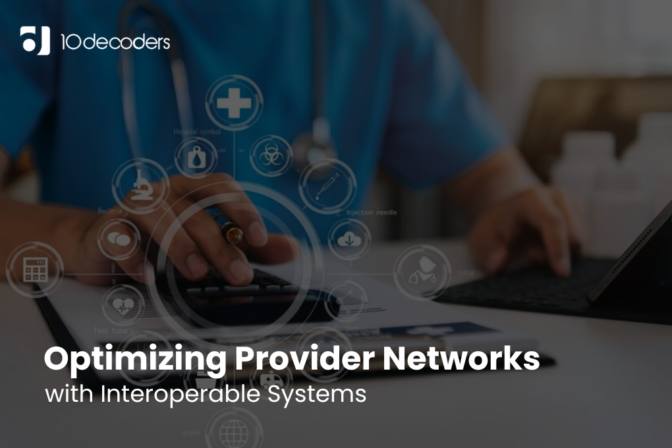Optimising Provider Networks with Interoperable Systems
Provider networks play a pivotal role in the healthcare ecosystem, connecting patients to a diverse range of specialists and medical resources. However, managing these networks effectively can be a complex challenge, requiring accurate data insights, coordinated care delivery, and optimal resource allocation. In this landscape, interoperability emerges as a game-changer, empowering healthcare organisations to leverage data and optimise their provider networks for improved patient outcomes and system-wide efficiency.
Understanding the Challenges of Provider Network Management
Navigating the multifaceted realm of provider network management necessitates addressing inherent challenges
- Data Fragmentation: Patient information often resides in siloed systems across different providers, hindering comprehensive understanding of network performance and patient care flow.
- Lack of Transparency: Limited visibility into provider quality, utilisation patterns, and referral pathways impedes informed decision-making regarding network design and resource allocation.
- Care Coordination Gaps: Disconnectedness between providers within the network can lead to fragmented care, duplicate services, and potential adverse outcomes for patients.
- Administrative Burdens: Manual data exchange and communication between providers and network administrators generate unnecessary administrative overhead, reducing time and resources dedicated to patient care.
These challenges ultimately affect patients, providers, and the healthcare system as a whole
- Patients: Fragmented care and communication gaps can lead to suboptimal outcomes, decreased satisfaction, and higher healthcare costs.
- Providers: Inefficient care pathways and duplicate services can increase workloads, decrease professional fulfilment, and impact financial viability.
- Healthcare System: Inability to optimise resource allocation within the network can lead to waste, inefficiency, and higher overall healthcare costs.
Interoperability: The Key to Network Optimization
Interoperability, characterised by the seamless exchange of healthcare data between disparate systems, holds the potential to transform provider network management. By fostering data-driven decision-making and enhancing care coordination, interoperable systems address the existing challenges
- Breaking Down Silos: Interoperable platforms unify patient data from across the network, providing a holistic view of care pathways, utilisation patterns, and provider performance.
- Enhancing Transparency: Real-time data on provider quality, referral patterns, and utilisation empowers network administrators to make informed decisions regarding network configuration and resource allocation.
- Facilitating Care Coordination: Secure patient data exchange between providers within the network enables seamless care transitions, reduces duplicate services, and promotes collaborative treatment plans.
- Automating Administrative Tasks: Automated data transfer and communication processes streamline administrative workflows, freeing up time and resources for patient care and network optimization.
The benefits of interoperable provider network management extend far beyond operational efficiency
- Improved Patient Outcomes: Coordinated care, informed clinical decisions, and reduced care fragmentation lead to better patient experiences and improved health outcomes.
- Enhanced Provider Satisfaction: Efficient workflows, streamlined communication, and data-driven feedback empower providers to deliver better care and improve their professional satisfaction.
- Reduced Healthcare Costs: Optimised resource allocation, prevention of duplicate services, and improved care coordination result in significant cost savings for both patients and the healthcare system.
- Data-Driven Insights: Interoperable systems provide invaluable data to analyse network performance, identify areas for improvement, and continuously refine network structure and resource allocation.
The Interoperable Network: Building the Future of Healthcare
Implementing interoperable systems for provider network management requires a multi-pronged approach
- Technological Infrastructure: Investing in robust interoperable platforms and data integration solutions is critical for seamless data exchange and analysis.
- Standardisation: Adopting and promoting universally accepted data standards like FHIR (Fast Healthcare Interoperability Resources) facilitates data exchange across diverse systems.
- Governance and Security: Implementing robust security protocols and privacy regulations ensures the safe and ethical exchange of sensitive patient data.
- Collaboration and Change Management: Fostering collaboration between network members, technology vendors, and policymakers is essential for successful implementation and ongoing optimization.
Conclusion: A Vision for Data-Driven Network Management
The future of provider network management lies in leveraging interoperable systems to optimise performance, empower providers, and deliver exceptional patient care. By breaking down data silos, fostering transparency, and facilitating coordinated care, interoperability transforms networks into dynamic data-driven entities, continuously evolving to meet the ever-changing needs of patients and the healthcare landscape. This journey towards an interoperable future necessitates sustained commitment, collaborative efforts, and a willingness to embrace innovation. However, the rewards are immense: a healthcare system where networks function as seamlessly as the human body, ensuring optimal care for patients, empowerment for providers, and a thriving, future-proof healthcare system for all.
This vision may seem like a distant horizon, but with each step we take towards interoperable networks, we move closer to a future where healthcare is truly connected, data-driven, and focused on delivering the best possible outcomes for every patient. So, let us embark on this journey together, harnessing the power of interoperability to build a healthcare system that thrives on collaboration, efficiency, and a shared commitment to patient well-being. The future of healthcare awaits, and it is powered by interoperable networks.



